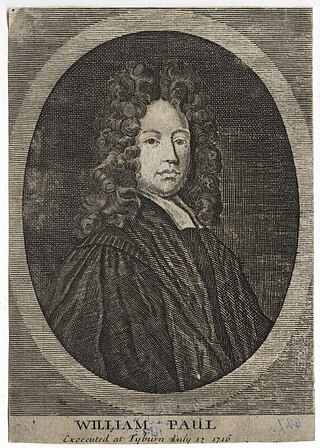
Waverley; or, ’Tis Sixty Years Since is a historical novel by Walter Scott (1771–1832). Scott was already famous as a poet, and chose to publish Waverley anonymously in 1814 as his first venture into prose fiction. It is often regarded as one of the first historical novels in the Western tradition.

James FitzJames Butler, 2nd Duke of Ormonde, (1665–1745) was an Irish statesman and soldier. He was the third of the Kilcash branch of the family to inherit the earldom of Ormond. Like his grandfather, the 1st Duke, he was raised as a Protestant, unlike his extended family who held to Roman Catholicism. He served in the campaign to put down the Monmouth Rebellion, in the Williamite War in Ireland, in the Nine Years' War and in the War of the Spanish Succession but was accused of treason and went into exile after the Jacobite rising of 1715.
The Tories were a loosely organised political faction and later a political party, in the Parliaments of England, Scotland, Ireland, Great Britain and the United Kingdom. They first emerged during the 1679 Exclusion Crisis, when they opposed Whig efforts to exclude James, Duke of York from the succession on the grounds of his Catholicism. Despite their fervent opposition to state-sponsored Catholicism, Tories opposed his exclusion because of their belief that inheritance based on birth was the foundation of a stable society.

The Battle of Preston was the final action of the Jacobite rising of 1715, an attempt to put James Francis Edward Stuart on the British throne in place of George I. After two days of street-fighting, the Jacobite commander Thomas Forster surrendered to government troops under General Charles Wills. It was arguably the last battle fought on English soil.
William Maxwell, 5th Earl of Nithsdale, was a Roman Catholic member of the Scottish nobility who took part in the Jacobite rising of 1715. He was attainted with his titles forfeited. However, Lord Nithsdale made a celebrated escape from the Tower of London by changing clothes with his wife's maid the day before he was due to be executed. The lordship of Herries of Terregles was later restored to his descendants and remains extant.

William Gordon, 6th Viscount of Kenmure and Lord Lochinvar was a Scottish Jacobite.

John Erskine, 23rd and 6th Earl of Mar and 1st Duke of Mar KT, was a Scottish nobleman and a key figure in the Jacobite movement. He held the title of the 23rd Earl of Mar from the earldom's first creation and was the sixth earl in its seventh creation. Erskine, often remembered for his political adaptability, navigated the complex and shifting landscape of early 18th-century British politics.

Clan Sinclair is a Highland Scottish clan which holds the lands of Caithness, the Orkney Islands, and the Lothians. The chiefs of the clan were the Barons of Roslin and later the Earls of Orkney and Earls of Caithness.

The Battle of Clifton Moor took place on the evening of Wednesday 18 December during the Jacobite rising of 1745. Following the decision to retreat from Derby on 6 December, the fast-moving Jacobite army split into three smaller columns; on the morning of 18th, a small force of dragoons led by Cumberland and Sir Philip Honywood made contact with the Jacobite rearguard, at that point commanded by Lord George Murray.
George Seton, 5th Earl of Winton was a Scottish nobleman who took part in the Jacobite rising of 1715 supporting "The Old Pretender" James Stuart. Captured by the English, Seton was tried and sentenced to death, but escaped and lived the rest of his life in exile.

Thomas Forster, of Adderstone Hall, Northumberland, was an English landowner and Tory politician who sat in the House of Commons from 1708 to 1716. He served as a general of the Jacobite army in the 1715 Uprising and subsequently fled to France.

James Radclyffe, 3rd Earl of Derwentwater was an English peer who participated in the Jacobite rising of 1715 and was executed for treason.
Events from the year 1715 in Great Britain.
The Jacobite uprising in Cornwall of 1715 was an unsuccessful Jacobite attempt at launching a rebellion against the Hanoverian regime which took place in the county of Cornwall.

The Jacobite rising of 1715 was the attempt by James Edward Stuart to regain the thrones of England, Ireland and Scotland for the exiled Stuarts.

The Battle of Glen Affric took place in 1721 in Glen Affric, in the Scottish Highlands. It was fought between Government backed forces of the Clan Ross against rebel the forces of the Clan Mackenzie and their allies the Clan Macrae.
William Murray, 2nd Lord Nairne was a Scottish peer and Jacobite who fought in the Rising of 1715, after which he was attainted and condemned to death for treason, but in 1717 he was indemnified and released.
Charles Wogan (1684–1754) was a Jacobite activist, also known as the Chevalier Wogan.
Henry Oxburgh was an Irish soldier and Jacobite who was one of the leaders of the Jacobite rising of 1715 in England. Captured by forces loyal to the Hanoverian Dynasty following the Battle of Preston, he was executed at Tyburn for high treason.

William Paul (1678–1716), Vicar of Orton, was a nonjuring Church of England clergyman and Jacobite sympathizer, executed for treason.